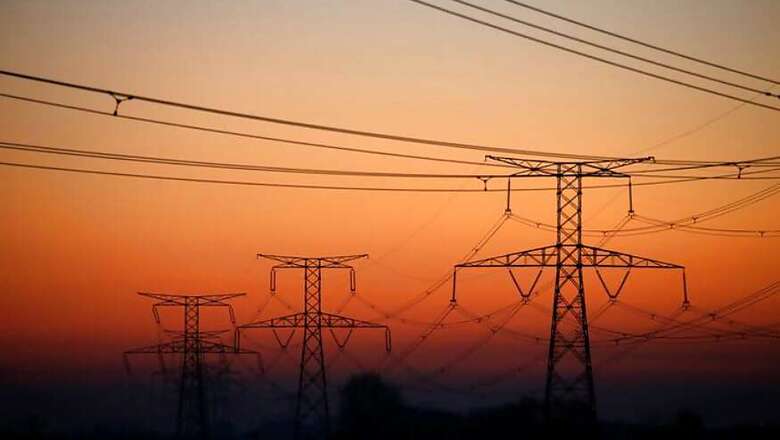
views
New Delhi: At the launch of the Coal 2018 report by the International Energy Agency (IEA), director of energy markets and security Seisuke Sadamori said: “The story of coal is a tale of two worlds with climate action policies and economic forces leading to closing coal power plants in some countries, while coal continues to play a part in securing access to affordable energy in others.”
Come 2019, India’s coal story has found its mention within these two worlds: electricity demand growth has dropped for the first time in decades, while renewable energy production, if not fulfilling complete demand, is on the rise. All this, when the economy is on track of slow growth for the six consecutive quarters.
Union Minister for Coal and Mines Pralhad Joshi on Wednesday told the Parliament that the coal sector recorded “negative growth” of 3.7 per cent between April-September 2019. But, overall, raw coal production in the country witnessed an absolute increase of 164.58 million tons (MT) in 2018-19.
The Minister said the drop in coal production is “largely because of heavy rainfall witnessed in coal mining areas of the country” that hampered production.
That India imported 234 MT coal last year, losing Rs 1.7 lakh crore foreign exchange, to meet its electricity demands raises concerns over the recent slump as coal is still the most affordable source of energy.
Economic Slowdown
Electricity demand since the turn of the century has increased rapidly and increased coal production has met this demand. According to data from Central Electricity Authority, 72% of India’s electricity is generated from fossil fuels, contributing to more than half of its CO2 emissions.
The IEA’s Coal 2018 report said that global coal demand grew by 1% in 2017 after two years of decline, mainly due to global economic growth. It added that this is likely to “remain stable” until 2023 due to western Europe and America moving towards renewable sources of energy, and Asian countries like India still banking on its “affordability and availability”.
However, an analysis by the Brookings Institution India’s Carbon Tracker revealed that grid level demand fell below 100 GW after a long while post Diwali this year. Low demand for electricity translates to low coal production, Dr Rahul Tongia, fellow for energy and climate at Brookings, told News18.
The country was previously hit with low coal production in 2017 following the demonetisation which affected the construction sector as cement, steel output growth fell to 0.5 per cent and 5.6 per cent, respectively.
But, with the current state of the economy, low electricity demand is particularly troubling for India. “This year had extended rains (lowering coal demand and raising hydro output) and higher renewable energy (monsoon), both of which lowered coal in certain time periods. The electricity demand to GDP is a more important metric than coal to GDP, for the reasons above,” said Tongia.
He added, “One could postulate that electricity sales to industry are measurably down, and if they're disproportionally down, then this could be an indicator of a manufacturing slowdown.”
Indeed, according to the World Bank’s estimates, the manufacturing sector’s share in Indian GDP has wandered between 14-15 per cent since 2015. It fell from 15.58 per cent in 2015 to 14.87 per cent in 2017, before marginally rising in 2018.
In November, Lauri Myllyvirta, lead analyst at Centre for Research on Energy and Clean Air (CREA), Dave Jones at Sandbag and Tim Buckley at the Institute for Energy Economics and Financial Analysis (IEEFA) conducted an analysis of electricity generated by coal globally.
They found global coal power generation is headed to a fall of below 3% or 300 terawatt hours (TWh) in 2019, the largest drop on record.
This has already reduced exports in countries exposed to trade with coal-fired power generating countries like China, South Korea and Japan. It’s an economic hit for coal plants due to reduced average running hours, according to the trio’s analysis.
Myllyvirta said that within this global scenario, a decline in electricity demand in India by 13.2% in October, as compared to last year, makes further slowdown in Indian economy increasingly apparent.
The power and renewable energy minister’s recent statement in the Lok Sabha confirming that electricity distribution companies have been asked to pay-and-carry power and not to supply power on credit presents a much damning future. “Over dues outstanding amount of (electricity) generating companies has increased to Rs 65,000 crore,” the minister said.
Of the above figure, electricity distribution companies in Andhra Pradesh, Tamil Nadu, Telangana, Karnataka, Madhya Pradesh, Rajasthan and Maharashtra have outstanding dues to renewable energy generators (Wind and Solar) amounting to approximately Rs 10,000 crore.
Rise of Renewables
India’s fuel switching economy, both Myllyvirta and Tongia agree, makes more sense to look at via total electricity demand, and not power generation from coal alone. According to data, total electricity generation grew by 1% in this fiscal (Apr-Oct 2019 compared with 2018), which is a slower growth rate but still an increase. At the same time, thermal power generation fell by 2%.
“Two things are happening here: manufacturing slowdown, which is a negative trend for the economy, and success in increasing power generation from cleaner sources, which is a positive,” said Myllyvirta.
In recent years, coal has witnessed a shrinking share in the demand for electricity. The commitment to achieve 40 per cent of its total electricity generation from non-fossil fuel sources, as agreed in the Paris Agreement, has made a turnaround in India’s energy graph.
But, “rising renewable energy, hasn't killed the growth of coal, but it has slowed it down a lot (on a multi-year timescale),” Tongia pointed.
According to the Central Electricity Authority, the first six months of 2019 witnessed hydro, solar and wind energy contribute to 70 per cent of the increase in electricity demand in India. An analysis of this data revealed solar power generation grew by 30 per cent, while hydro power grew by 22 per cent within this period.
However, renewable energy sources generate only a tenth of the total electricity generated in the country. In 2018-19, renewables generated 126.75 billion units (BU) of electricity which is around 9.21 per cent of the total electricity generated, union minister for power, new and renewable energy RK Singh told the Parliament.
As the first country to set up a ministry for non-conventional sources of energy, India’s renewables strategy is aiming to have 275 GW from renewable energy, 15 GW from nuclear energy and 100 GW from “other zero emission sources” by 2027. It is on track to achieve 175 GW interim target by 2022.
Presently, 35 per cent of India’s electricity comes from renewables, 55 per cent from coal and 2 per cent from nuclear power.
Whether the rise of renewables is able to turn around India’s energy sources in the long run will depend on the affordability factor. According to Tongia, residential consumption of electricity is a fraction of the average sectoral cost.
“If the power sector in India uses 650 million tonnes of coal, and each tonne costs Rs. 3000, then each person spends about Rs. 1,500 on coal for electricity annually, on average,” he said.
“Coal remains India's swing and backstop producer of electricity.”
















Comments
0 comment